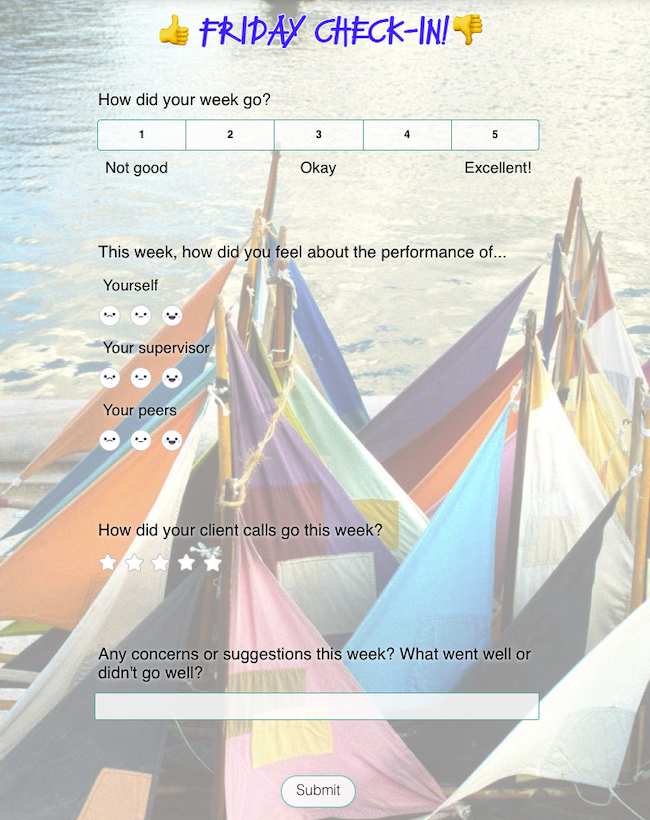“We all need people who will give us feedback. That’s how we improve.”
– Bill Gates
As this quote shows us, not only was Gates a tech whiz, he was also a visionary leader. The Microsoft founder welcomed feedback from his employees in order to make the company stronger. While he may not have been the founder of “feedback culture,” he certainly understood it.
So what exactly is feedback culture? It’s defined as an organizational environment where open, honest, and constructive feedback is consistently exchanged among team members, regardless of their standing in the company hierarchy. In fact, ClearCompany reveals that companies with a strong feedback culture are 21% more profitable and see a 24% lower employee turnover rate! Now, let’s dive a little deeper and learn how you can begin to cultivate this type of workplace structure through feedback surveys.
Create Your FREE Feedback Survey or Questionnaire Now!
8 Characteristics of a Feedback Culture
While not every organizational culture involves open communication, those that do are typically comprised of eight characteristics.
1. Open Communication
Leadership promotes transparency and openness by encouraging employees to share thoughts, concerns, ideas, and suggestions. These are all taken into consideration and followed up on, not dismissed or ignored without explanation.
2. Constructive Feedback
In a feedback culture, criticism must be constructive and given with positive intent. It cannot be delivered in order to demean or belittle someone. Constructive feedback must be specific, actionable, and aimed at improving performance and personal growth.
3. Regular Feedback
Feedback is given frequently, not just during formal review periods. Why? Gallup reports 43% of highly engaged employees receive feedback at least once a week, compared to 18% of employees with low engagement. Forbes also shows that 65% of employees want more feedback than they currently receive.
4. Two-Way Street
In a feedback culture, feedback is not just top-down (boss to subordinates) as used to be the norm, but also bottom-up. When employees have a platform to provide feedback on their managers and the overall structure, they are more engaged, trust is built, and management practices can be improved.
Peer-to-peer reviews are also common in a feedback culture to identify employee strengths and weaknesses, increase accountability, and reduce biases that might exist in a traditional top-down review process (when feedback comes from multiple sources, it provides a more balanced and fair evaluation of an employee’s performance). Peer reviews can also foster a sense of teamwork and mutual respect, as knowing that colleagues are evaluating their performance can encourage employees to collaborate more effectively and support each other’s success.
5. Safe Environment
Feedback culture must create a “safe space,” in other words everyone must be made to feel at ease giving and receiving feedback; there can be no fear of retaliation or worse, termination.
6. Empathy and Respect
Feedback is given with empathy and respect, focusing on behaviors and outcomes rather than personal attributes. The Society for Human Resource Management (SHRM) reveals that 92% of employees feel that feedback, when delivered with empathy and respect, is effective at improving performance.
7. Training and Support
Not everyone will be equally as comfortable giving feedback, especially if they come from an organizational culture where this was not encouraged or even frowned upon.
8. Recognition and Appreciation
Positive feedback and recognition are integral parts of feedback culture, celebrating achievements and reinforcing desired behaviors. There can be actual rewards involved (gift cards, etc). Or, it can simply be a “shout out” to a peer during a meeting.
Benefits of a Feedback Culture
A feedback culture offers numerous benefits that significantly enhance an organization’s overall health and productivity. It fosters continuous improvement by providing employees with regular, actionable insights into their performance, which helps them understand their strengths and areas for development. This ongoing dialogue increases employee engagement and motivation, as individuals feel valued and recognized for their contributions.
A feedback culture also encourages innovation and learning, as open communication allows for the free exchange of ideas and promotes a collaborative environment. Additionally, it strengthens relationships within teams by building trust and fostering a sense of psychological safety, where employees are comfortable sharing their thoughts without fear of negative repercussions. This environment of mutual respect and support aligns everyone with the organization’s goals and values, leading to a more cohesive and adaptive workplace.
Overall, a feedback culture not only boosts individual and team performance but also drives organizational success by creating a dynamic and responsive work environment.
Challenges In Creating a Feedback Culture
Some companies may struggle with implementing a feedback culture. One significant challenge is overcoming existing hierarchies and power dynamics that can inhibit open communication, making employees reluctant to give or receive feedback, especially if it involves superiors.
Another challenge is ensuring that feedback is constructive rather than critical or vague, which requires training and a shift in mindset. There is also the issue of creating a psychologically safe environment where individuals feel comfortable expressing honest opinions without fear of retaliation or negative consequences.
Resistance to change is another obstacle. Both leaders and employees may be accustomed to traditional performance review methods and might struggle with adopting continuous feedback practices. Additionally, there may be logistical challenges in establishing regular feedback mechanisms, such as finding the time for consistent one-on-one meetings or integrating effective feedback tools.
Create Your FREE Feedback Survey or Questionnaire Now!
7 Ways To Create a Feedback Culture
Despite the challenges of creating a feedback culture, there are some steps an organization can take to begin cultivating this type of environment.
1. Lead by Example
Leaders should model the behavior they wish to see, demonstrating openness to feedback. While it can be difficult for some of them to hear, especially if they come from a company where there were no bottom-up reviews, their acceptance of the process will go a long way toward making everyone more comfortable.
2. Provide Feedback Training
Companies can offer training sessions on how to give and receive feedback constructively. For example, holding group role-play exercises and team feedback practice scenarios.
3. Establish Clear Guidelines
Set clear expectations and guidelines for feedback processes. Make sure everyone understands what’s constructive and what’s not. Plus, when feedback is appropriate (one on one, with a supervisor, etc) and when it is not (in front of clients or customers).
4. Use Technology
Implement tools and platforms that facilitate feedback exchange. Online survey platforms are great methods of collecting feedback, while online employee chat rooms, like Microsoft Teams, can be used for employees and management to deliver “shout outs” throughout the day or week.
5. Encourage Regular Check-Ins
Promote regular one-on-one meetings and team reviews to discuss feedback. This can be difficult in fast-moving businesses where these meetings can fall through the cracks, so make sure employees schedule them into their calendars and only cancel or reschedule them when absolutely necessary.
6. Celebrate Feedback
Recognize and celebrate instances where feedback has led to positive changes, no matter how small. Seeing that feedback achieved positive results will encourage others to provide more feedback.
7. Monitor and Adjust
Continuously monitor the feedback culture and make adjustments as necessary to improve it. Creating and maintaining a feedback culture requires commitment and effort from all levels of an organization so it’s important to keep an eye on progress.
Create a Feedback Culture With Feedback Surveys
Online surveys are a great way to begin creating a feedback culture. They’re easy to create and easy to deploy, delivering them via email every week, bi-weekly, monthly, and so on.
Of course, people still have to work, so weekly microsurveys, which are quick 3-5 question surveys designed as a check-in, can be used. Here’s an example using SurveyLegend:
- Four questions
- Different types of questions for engagement
- A fun header and background to keep things informal.

A 360-degree feedback review is another great way to get feedback. It’s named as such for its comprehensive approach, as it collects performance feedback from an employee’s direct manager, peers, direct reports, and functional managers, as well as a self-assessment. This method provides a well-rounded view of an employee’s performance, focusing on areas such as accountability, leadership, interpersonal skills, problem-solving, teamwork, and vision.
This 360 feedback process is crucial for personal and professional growth, as it promotes self-awareness by comparing self-ratings with others’ perceptions. Interested in creating one? You may want to read our blog first, 360-Degree Feedback Question + Sample Performance Review. Or, you may want to create an anonymous survey, to keep responses honest and reduce fear of retaliation. We have a blog on that too, How To Get Anonymous Feedback Using Online Surveys. Otherwise, you are free to start with SurveyLegend today (literally, it’s free to start). And remember, as motivational speaker Ken Blanchard says, “Feedback is the breakfast of champions!”
Have you worked in a feedback culture before? Did you find it more rewarding than other organizational cultures? Share your experiences with us in the comments!
Create Your FREE Feedback Survey or Questionnaire Now!
Frequently Asked Questions (FAQs)
There are no hard numbers on this, however practices such as bottom-up and peer-to-peer reviews have been increasing as organizations recognize the benefits of continuous feedback mechanisms. According to Deloitte, more than 85% of organizations cite employee experience as a top priority, with many focusing on continuous feedback mechanisms as a critical component.
Some people don’t like feedback culture because they may be sensitive to criticism and find frequent feedback discouraging or demoralizing. Poorly delivered feedback can feel harsh or unfair, leading to resentment and discomfort. Cultural differences in communication styles and power dynamics can make giving and receiving feedback challenging and uncomfortable. Additionally, the frequency of feedback can be overwhelming, causing feedback fatigue and reducing its effectiveness.
Blanchard is a mouthpiece for feedback culture, as well as a motivational speaker and author of more than 70 business-oriented books. He is famous for saying, “Feedback is the breakfast of champions.”





